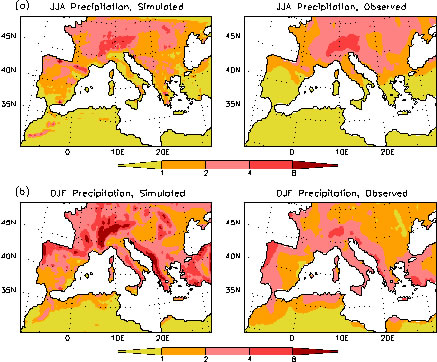Incorporating vegetation dynamics in regional climate change projections of Southern Europe and Mediterranean
Recent projections of climate change over Southern Europe and the Mediterranean basin from general circulation and regional climate models show strong warming and pronounced decrease in precipitation over large portion of the region, especially in the summer. While the role of vegetation in modulating the region’s climate is widely recognized, most, if not all, of these climate change projections do not account for the response of the dynamic biosphere to the potential climate changes. In this study we we used a linked regional climate-vegetation model to explore the effects of dynamic vegetation on climate prediction over the Mediterranean region.
Figure 1: Regional model simulated and observed summer (JJA) and winter (DJF) precipitation climatology
Our simulations without dynamic vegetation show surface temperature increases across the entire domain in 2085-2089 relative to 1985-1989, due to the radiative and physiological effects of CO2. Analysis of spatial patterns of changes for sub-regions of our domain reveal that apart from France which exhibits a precipitation decrease in JJA but an increase in DJF, the Iberian Peninsula, Mediterranean, Turkey, the Alpine and Eastern Europe all show substantial precipitation decreases both in JJA and DJF as a result of the radiative and physiological effects of elevated CO2. Corresponding to these precipitation decreases, are evapotranspiration decreases from these areas; the exception being areas that are strongly no water-limited (e.g. the ALPS) and so exhibit an increase caused by the higher evaporative demand of the atmosphere due to warming. Surface runoff changes substantially only over IBE during JJA where precipitation decrease is also substantial. In general, the sign of surface runoff changes across the domain closely follow that of precipitation changes. So is the soil moisture change signal with the reduced transpiration due to stomatal closure under enhanced atmospheric CO2 concentrations contributing to, or modifying, the soil moisture response According to the simulations accounting for dynamic vegetation, changes in vegetation density are widespread, with substantial changes in fractional coverage of vegetation types. Deciduous tree cover decreases by 60% and 40% in the Alpine and Mediterranean regions, respectively, while grass cover increases by 56% and 19% in North Africa and Eastern Europe, respectively. Also, grass cover decreases in France and the Iberian Peninsula by 51% and 31%, respectively. These changes in vegetation cover significantly alter the modeled climate and hydrological changes due to the radiative and physiological effects of elevated CO2. For instance, JJA warming of 5.8°K and 28% precipitation reduction due to radiative and physiological CO2 effects are simulated for the Mediterranean; including effects of changes in vegetation reduces the warming to 4.9°K, and modifies the precipitation decrease to a 4% increase. Over France, however, vegetation feedback effects reduce the JJA warming of 5.8°K by only 0.2°K, and the 49% JJA rainfall reduction by 5%. This highlights the high degree of geographical dependency of the effect of vegetation feedback on the climate system. We note that our simulations do not account for land cover changes due to human land use changes. While simulating how anthropogenic activities will alter the land surface in the future remains a challenge, model simulations suggest that global anthropogenic land cover changes may have larger effects on the 21st-century climate than natural vegetation changes (review by Levis 2010). Furthermore, our modeled vegetation responses and associated effects are subject to the uncertainty about the extent to which vegetation productivity might be enhanced by CO2 enrichment. The regional climate and vegetation model were not synchronously coupled and this is a limitation of the design of our study. We also used lateral boundary conditions from only one GCM to drive the regional model. These limitations notwithstanding, our methodology allowed us to address the question posed in the Introduction section: “How important is the two-way interaction between vegetation and climate for predicting future climate over Southern Europe and the Mediterranean?” Results demonstrate that vegetation dynamics play an important role in climate predictability over this region, thus emphasizing the need to include vegetation dynamics in future climate predictions.
|
Predicting Floods With Distributed Hydrological Models
Using Satellite Data to Study Water Cycle Parameters
Measuring Rainfall Using Mobile Weather Radar
Measuring Rainfall over the Oceans Using Underwater Sound Data
Numerical Weather Prediction Air- Sea interactions
Coastal Ecosystem and Water Quality Climate Research
Soil Water - Climate interactions
|
Hellenic Center for Marine Research - Institute of Inland Waters PreWec Marie Curie Excellence Research Team |
People



